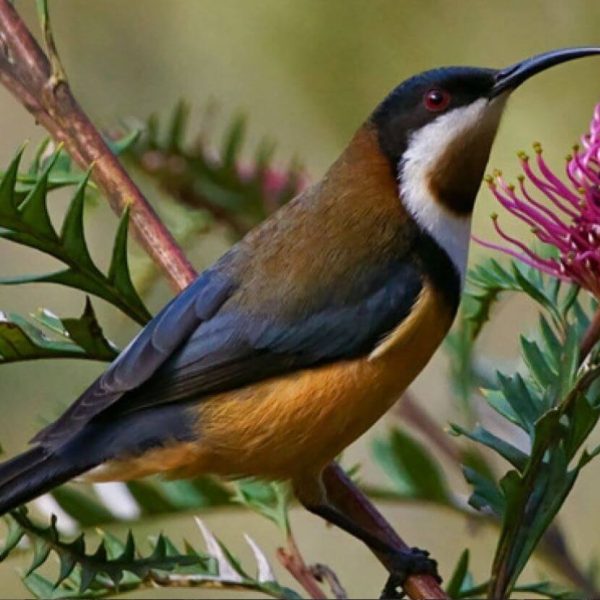

The Eastern Spinebill Honeyeater: A Sweet Serenade in the Bush at Murphys Creek Escape
For avid birdwatchers exploring the pristine landscapes of Murphys Creek Escape in South East Queensland, the Honeyeater is undoubtedly one of the most melodious and captivating avian residents you can encounter. These charming birds, belonging to the family Meliphagidae, are renowned for their love of nectar, vibrant plumage, and enchanting songs.
Overview of The Honeyeater

Physical Characteristics
Prepare to be entranced by the Honeyeater’s distinct physical attributes:
- Specialised Bills: Honeyeaters are equipped with specialised bills designed for extracting nectar from flowers. These bills come in various shapes and sizes to cater to different nectar sources.
- Vibrant Plumage:
- A Rainbow of Colors: Honeyeaters showcase a stunning array of colors, ranging from bright greens, yellows, and oranges to deep reds and striking blues. These vibrant hues adorn different parts of their bodies, creating a captivating visual spectacle amidst the lush bushland of Murphys Creek Escape.
- Distinctive Patterns: In addition to their brilliant colors, Honeyeaters often feature distinctive patterns and markings. Some species have intricate patterns on their wings, tails, or throats, adding to their charm and uniqueness.
- Sexual Dimorphism: In many Honeyeater species, males and females may display slight differences in plumage. These differences can include variations in color intensity or specific markings. Observing these subtle distinctions can be an exciting aspect of birdwatching.
- Charming Size: The size of Honeyeaters can vary depending on the species. Generally, Honeyeaters are small to moderately-sized birds, with most species falling in the range of 10 to 20 centimeters (4 to 8 inches) in length. However, there are exceptions, with some Honeyeater species being smaller, around 10-12 centimeters (4-5 inches), while others can be larger, reaching up to 25 centimeters (10 inches) in length. It’s important to note that within the diverse family of Honeyeaters (Meliphagidae), there are many different species, each with its own unique size and physical characteristics. Therefore, the size of a Honeyeater you encounter during birdwatching at Murphys Creek Escape in South East Queensland may vary depending on the specific species you are observing.
Habitats and Range
In the lush and diverse habitats of Murphys Creek Escape, you can observe Honeyeaters in various environments, including:
- Woodlands and Forests: Many Honeyeater species find their home in woodlands and forests, where they skillfully forage for nectar and insects among the foliage.
- Heathlands: Some Honeyeaters are specially adapted to heathland environments, where they seek out nectar from shrubs and flowering plants.
- Gardens and Parks: Certain species have acclimated to urban life, making gardens and parks their foraging grounds as they search for nectar-rich flowers.
Diet and Feeding Habits
Nectar from flowers is the primary dietary staple of Honeyeaters and serves as their main source of energy. Their specialized tongues allow them to efficiently extract nectar from deep within blossoms. Alongside nectar, Honeyeaters may also feed on:
- Insects: Many species complement their diet with insects, which provide essential proteins and nutrients, especially during the breeding season.
- Fruits: Some Honeyeaters include fruits and berries in their diet, contributing to the dispersal of seeds in their ecosystems.
Breeding and Behavior: The breeding behaviors of Honeyeaters are as diverse as their species. Intricate cup-shaped nests are often constructed, sometimes bound together with spider silk. During the breeding season, courtship displays, vocalisations, and territorial behaviors are common sights.
Conservation Status
While Honeyeaters are not generally considered endangered, preserving their natural habitats is crucial for their continued presence. Threats such as deforestation, habitat degradation, and climate change can affect their populations.
In conclusion, the Honeyeater is a charming and ecologically significant bird species. Their role as pollinators and nectar enthusiasts contributes to the vitality of their ecosystems. For birdwatchers and nature enthusiasts at Murphys Creek Escape, encountering the Honeyeater in its natural habitat offers a harmonious symphony of both visual and auditory delights, showcasing the remarkable diversity of avian life in South East Queensland’s pristine bushland.
